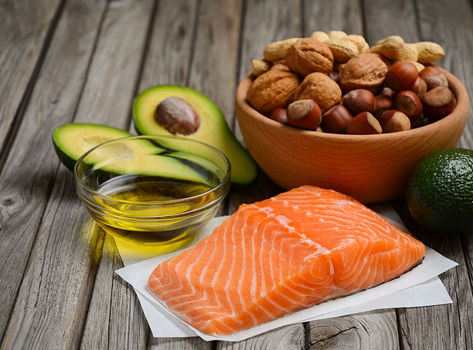
Fats have a bad reputation. Historically, fatty foods were blamed for causing obesity and chronic disease. But today’s scientific research paints a different picture with experts agreeing that healthy fats are important in overall health and should be part of our daily diet.
“A balanced diet consists of three macronutrients: carbohydrates, proteins and fats — yes, fats. They’re an important nutrition source,” says Julia Davidson, RD, MS, RDN, CDCES, a certified diabetes educator and dietitian with Atlantic Health System.
Julia explains that many people think they need to cut fats out completely or follow a low-fat diet to lose weight. But she cautions that our bodies need healthy fats for optimal function, and instead of eliminating this important macronutrient, we should consume small amounts of healthy fats in meals and snacks.
Healthy vs. Not-So-Healthy Fats
Fats make foods taste good. They help you feel full longer. They support immune function. They also help the body absorb fat-soluble nutrients. But some fats are better than others.
- Healthy fats are mono and polyunsaturated fatty acids. They are found in nuts, seeds, fish, avocados, plant-based oils, nut butters and olives.
- Less-healthy fats are saturated and trans fats. They are found naturally in butter, ice cream, red meats, and cheese, or in artificially processed cereals, chips and candies.
“Red meats, fried foods and processed snacks contain less-healthy, saturated fats,” says Julia. “So do most dairy products, so you want to consume low-fat dairy. For example, instead of drinking whole milk, try 1% or fat-free milk.”
Reading Food Labels
Julia also stresses how important it is to read food labels.
“The amount of fat you consume daily is individualized, but an average 2,000-calorie-a-day diet should include somewhere between 44 and 78 grams of healthy fats daily. So, before you toss foods into your cart at the grocery store, look at the ingredient list.
“Fats in your foods should contain mono and polyunsaturated fats with limited saturated and trans fats,” says Julia. “Whatever is first on the ingredients list is most prominent in that food. For example, if sugar is listed first, then that food product is mostly sugar. The same goes for fats.”
Healthy Fats and Cardiovascular Disease
One of the best things you can do for your heart is to clean up your fat intake. This will help reduce your risk of cardiovascular disease, especially if you’re living with diabetes. Studies show that consuming healthier fats can help decrease your heart disease risk, along with lifestyle factors.
“Eating fats doesn’t make you fat as long as you're consuming healthy fats at proper portion sizes,” says Julia. “If you’re overeating nuts, olive oils, or nut butters for example — even though they’re great source of healthy fats — you’re likely eating too many calories. That’s why it’s important to read the food label and understand portion sizes.”
Incorporating Healthy Fats in Your Diet
“The simpler we can make nutrition, the easier it is for our patients to follow the recommendations and set themselves up for success,” says Julia, who explains that eliminating fats or any food group might lead to weight loss but won’t be sustainable. “Just follow the 80/20 rule when it comes to eating. When you make healthy choices 80% of the time, you’ll indulge less, minimize binge eating and maintain balance in your diet that works in your everyday life.”
Be Proactive About Your Health
To stay safe and healthy, it's good to have a primary care provider who knows and understands your health history and wellness goals.